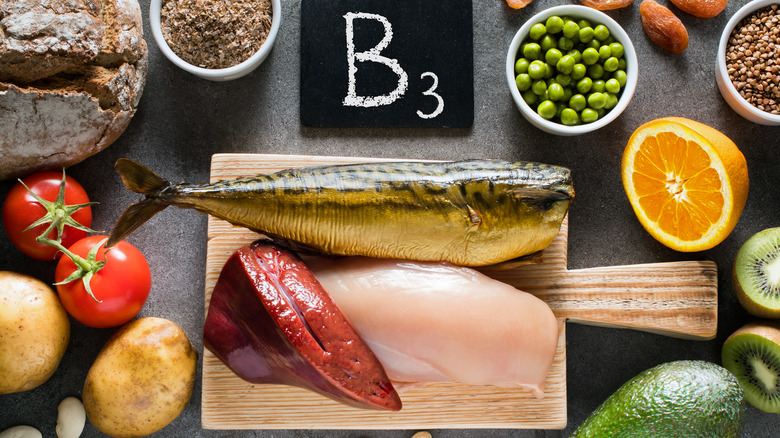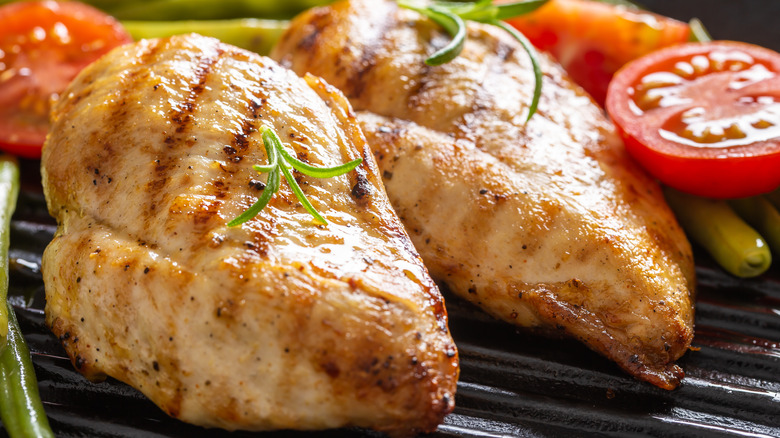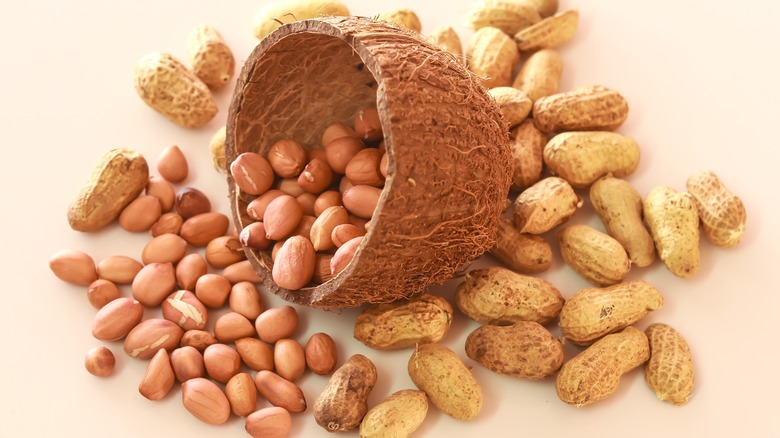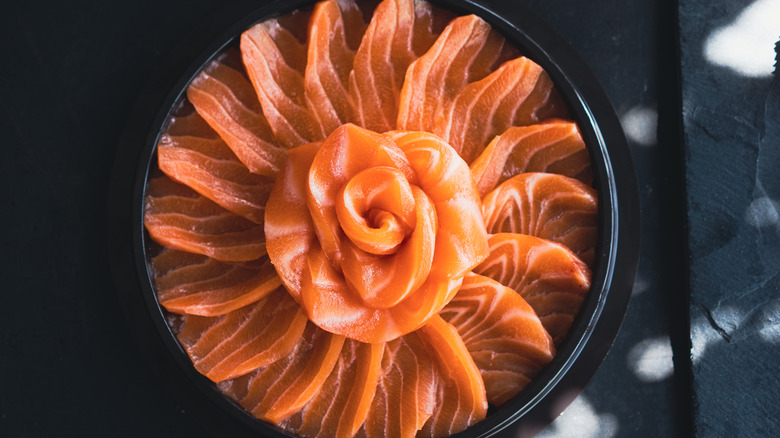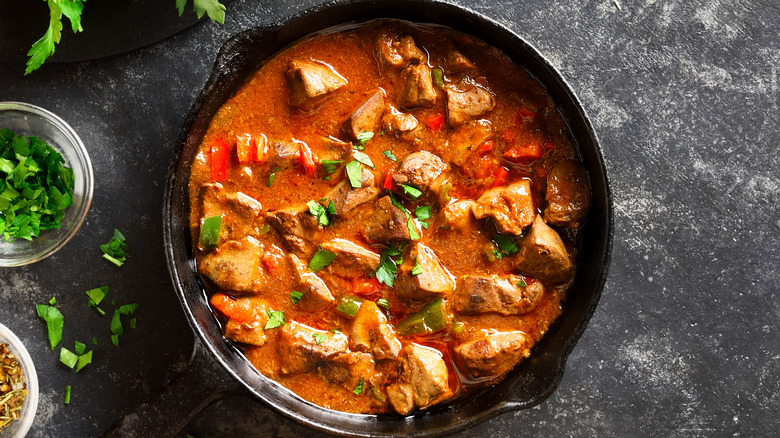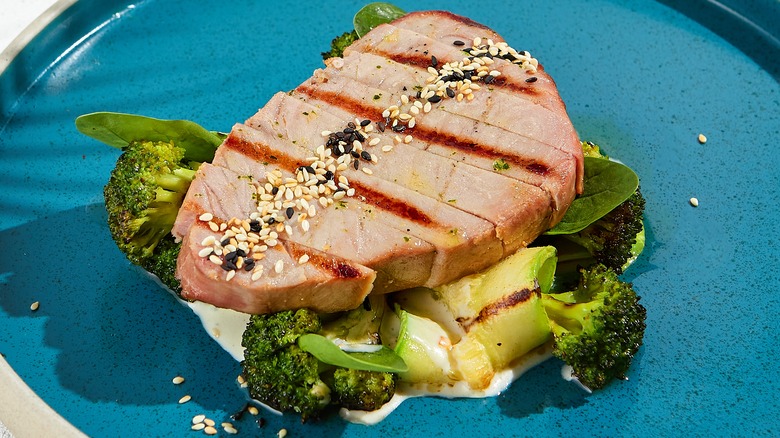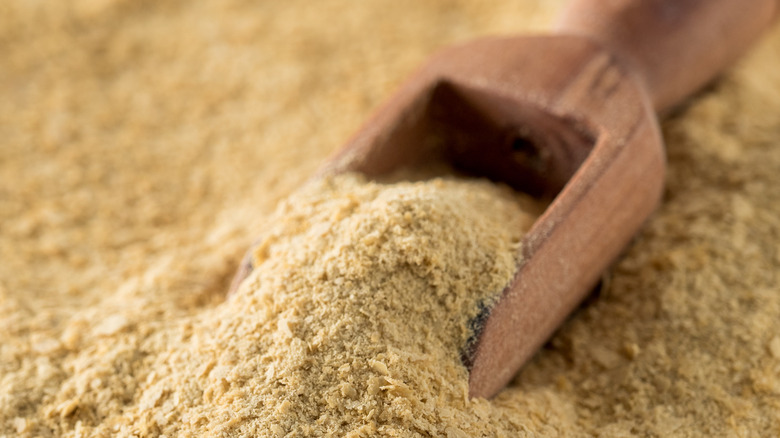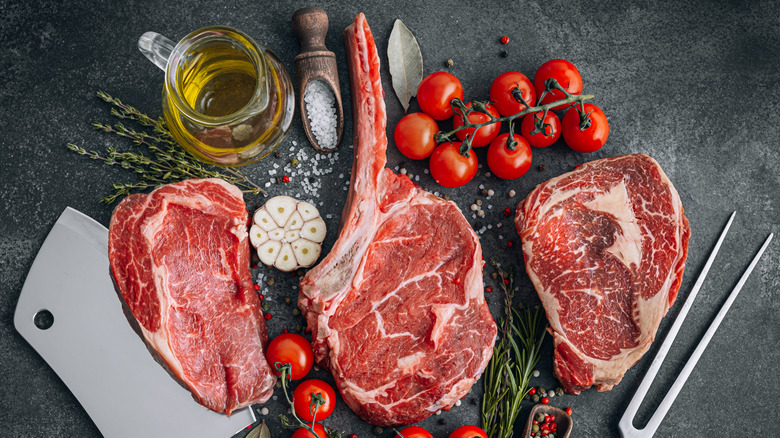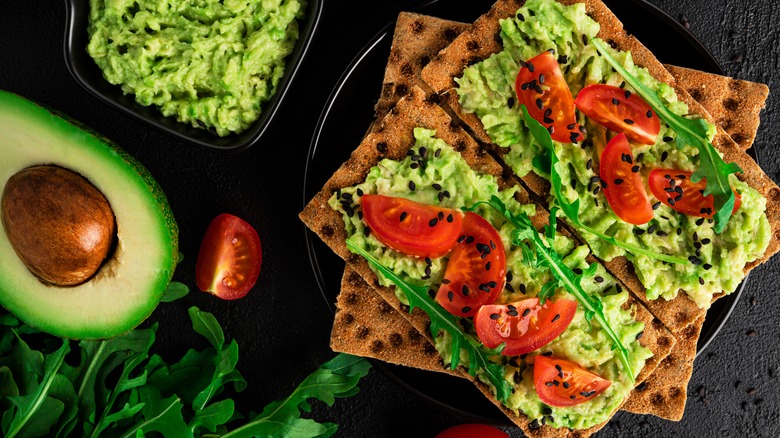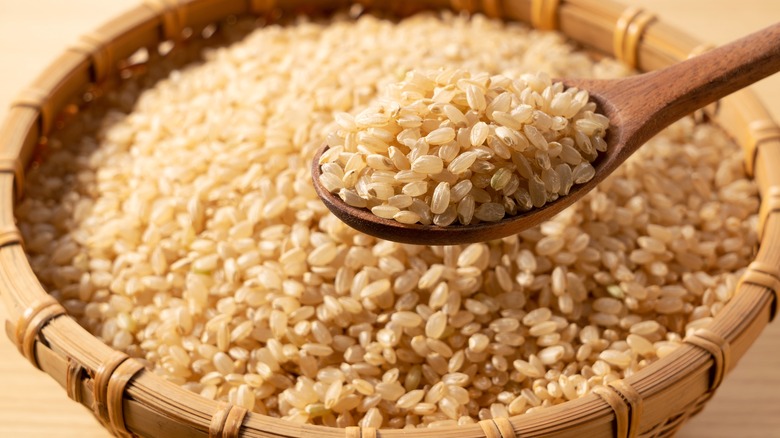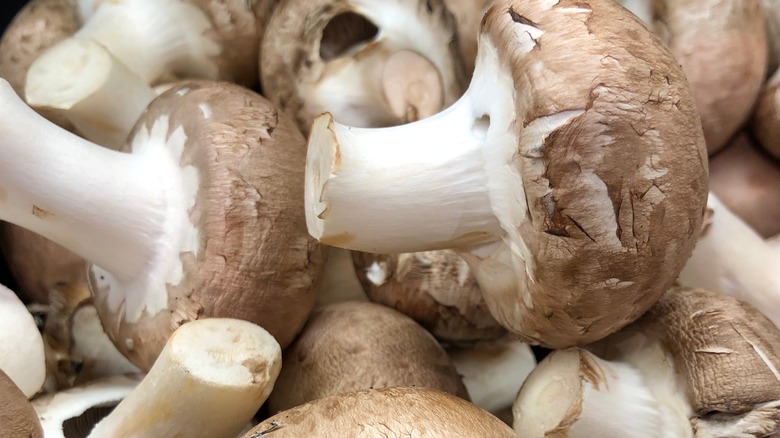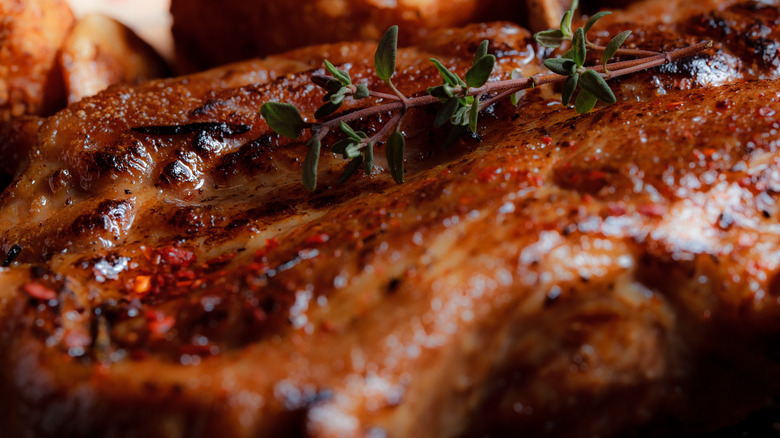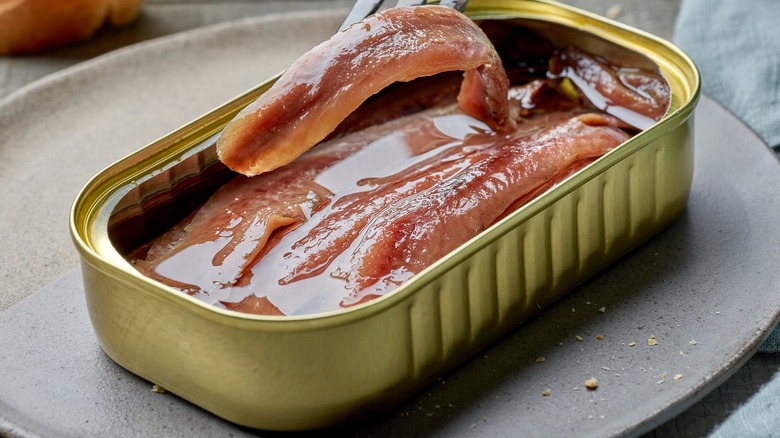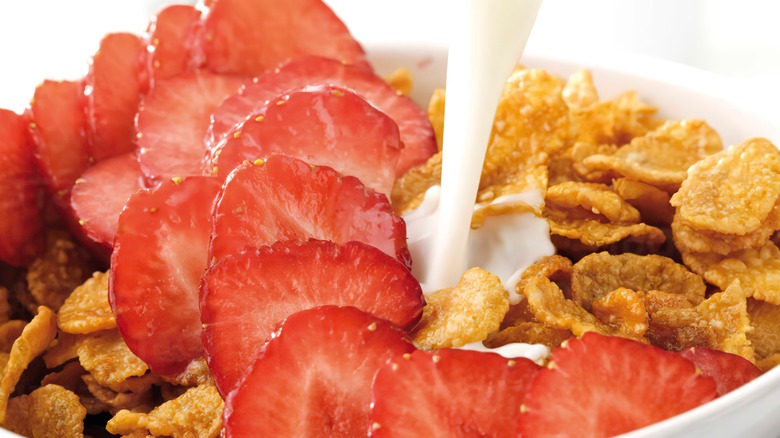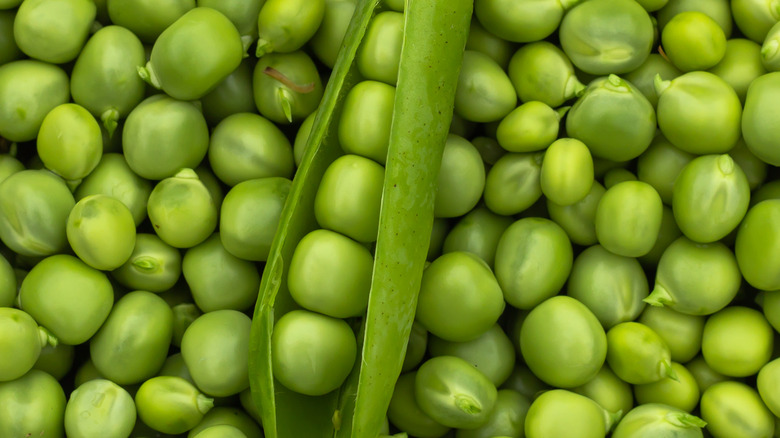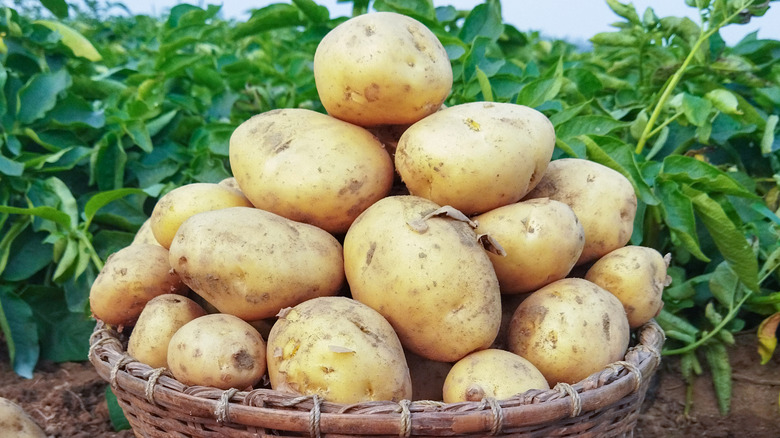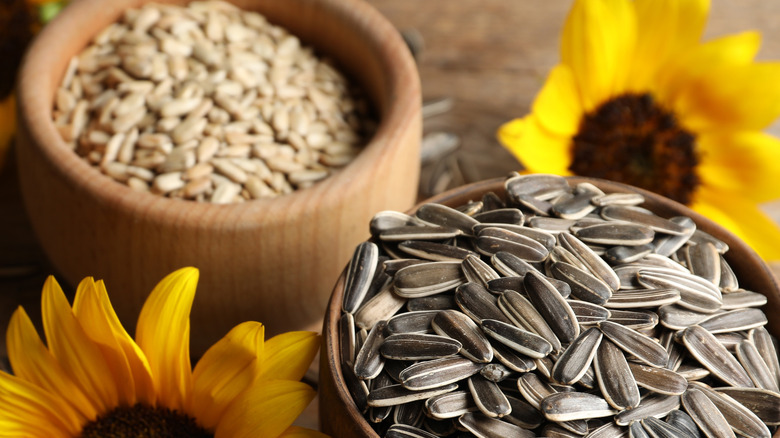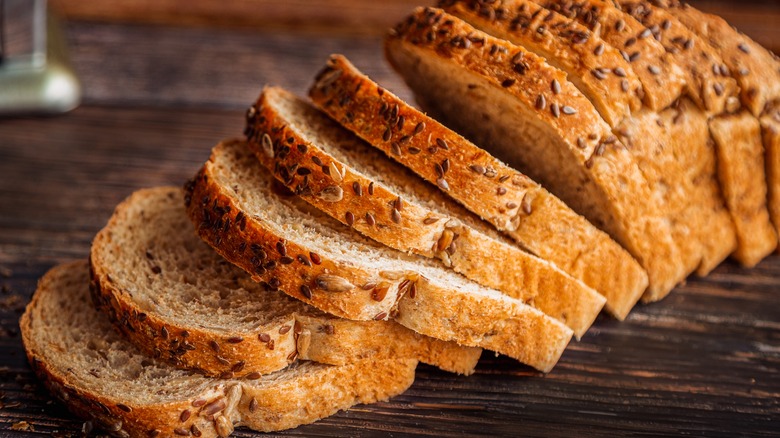17 Foods That Are High In Vitamin B3
Let's face it, folks: When it comes to our diets, there's a lot to consider. Not only do we have to keep track of getting the carbs, proteins, and fats we need for our body to stay running, but on top of that, there's a dizzying array of nutrients necessary to keep it functioning well. And vitamin B3 (also known as niacin) is a vitamin that you really can't forget about.
A member of the B vitamin family, vitamin B3 works to turn what we eat into usable energy, with the nutrient also working to turn our fuel, including proteins and fats, into sustenance that maintains healthy bodily function (per Mount Sinai). Your nervous system, eyes, hair, skin, and liver all benefit from having healthy levels of vitamin B3, with hormonal function and proper circulation also being supported. Trust us when we say that this is a nutrient you don't want to lose track of in your diet.
But never fear! The good news is that vitamin B3 is in a lot of the foods that we eat. And by ensuring that you're following a well-balanced diet rich in the following foods, you'll make sure you're never wanting for niacin again. Here's our list of vitamin B3-rich foods.
Chicken breast
The endlessly-versatile chicken breast is a protein powerhouse, and can slot nicely into pretty much any dish you're making. And that's good news for those adventurous chefs out there, because whether you're making pad thai or a chicken tikka masala, your niacin levels will be benefitting.
Chicken breast is particularly abundant in vitamin B3. It is one of the best sources of the nutrient that you can be consuming, pound-for-pound: Just three ounces of grilled chicken breast will provide over 10 milligrams of niacin, which is almost two-thirds of your recommended daily value, as the National Institutes of Health states.
What's more, the health benefits of chicken breast don't stop there. Chicken breast is also a great source of other B vitamins like B12, as well as vital minerals like copper, zinc, and iron (per WebMD). The niacin in chicken breast will aid your body in processing the high levels of protein that come from the meat, with the amino acids contributing to stronger, healthier muscles. The supreme protein content in chicken will also assist in keeping your bones strong and healthy and help manage your appetite, keeping you fuller for longer.
Peanuts
It's easy to pick snacks that aren't so good for us, but if you're feeling peckish between meals, there are few better things to munch on than peanuts. Not only are these little legumes incredibly tasty, but they're also an excellent plant-based source of vitamin B3, either on their own or in peanut butter form, as Healthline discusses. By eating two tablespoons of peanut butter, you're receiving roughly 4.3 grams of niacin, which amounts to almost a third of the daily value required for women and a quarter for men.
What's more, peanuts aren't just high in niacin — they're high in niacin that the body can use. A study published in The Journal of Nutritional Science and Vitaminology found that after processing, up to 91.7% of the niacin in boiled or roasted peanuts was still available in the food. Additionally, peanuts are abundant in other vitamins (including vitamin B6 and vitamin E) and a range of minerals, and are a great source of monounsaturated fats and plant-based protein.
Just make sure that you're picking a pack of peanuts (or a jar of peanut butter) that's relatively unprocessed and low in additives and additional fats. "As a dietitian, I choose peanut butters that contain the fewest ingredients possible. If I can select a peanut butter that contains only peanuts and a touch of salt, that is the best choice in my book," states registered dietitian nutritionist Lauren Manaker (via Eat This, Not That!).
Salmon
Honestly, what can't salmon do? This protein-packed fish is not just pretty much the best source of health-boosting omega-3 fatty acids out there — supporting everything from brain function to joint health (per WebMD) — but also jam-packed with vitamin B3. Just half a large fillet of wild Atlantic salmon, weighing in at 198 grams, will provide an enormous 15.6mg of niacin, says the USDA. This niacin then goes to work converting the very energy that you get from the salmon into usable energy, and assisting in bolstering skin health, digestive function, and supporting your nervous system, as the Mayo Clinic states.
The vitamin B3 in salmon can also play a crucial role in maintaining healthy cells, Health says — and that's really just the start of the fish's benefits. Several components of salmon are tailor-made to support hormone function, with the tryptophan in the fish allowing your body to create ample melatonin and serotonin, and its selenium content reinforcing thyroid health. The vitamin B12 in salmon also boosts your energy levels, and its zinc content allows your immune system to stay healthy and operate at full capacity. And did we mention that it also tastes really, really good? No? Well, there's that, too.
Liver
When we think of meat, we tend to think of steaks, chicken breasts, and fish fillets, all of which come from animal muscles. But the organs of the cows and chickens that we eat can also provide sustenance — and in the case of liver meat, can provide some serious nutritional benefits.
Cow and chicken livers are especially high in niacin, and provide some of the most abundant levels of the vitamin out there from food sources, states WebMD. Three ounces (just 85 grams) of beef liver will deliver, on average, 14.9 milligrams of vitamin B3. Chicken liver is also rich in niacin, with approximately 9.3 milligrams per three ounces.
However, while eating animal liver might help bolster your niacin levels, it may not, in larger quantities, help your own organs. Consuming too much vitamin B3 may result in liver damage, and people with liver disease should avoid taking significantly high levels of it (per the Mayo Clinic). Taking especially high levels of niacin has been found to produce dangerous, even life-threatening toxic effects on the liver, as shown in research published in LiverTox (via the National Library of Medicine). It's worth pointing out, however, that side effects are only likely to occur if you're consuming between 2,000 and 6000 milligrams of niacin per day.
Tuna
Tuna is at home in a sandwich as it is in fillet form on your plate. And no matter how you're eating the flavorful fish, you can rest easy in the fact that your body will be thanking you for the vitamin B3.
One can of tuna can allow you to obtain your entire recommended daily value of niacin in one go, according to Healthline. A single 165-gram can of tuna fish contains almost 22 milligrams of vitamin B3, which (for both men and women) is above what you need per day. And if you prefer your tuna in a rich, juicy steak, you're in even more luck: Half a fillet of skipjack tuna, weighing in at 198 grams, will deliver a massive 30.5 milligrams of niacin in one go (per the USDA).
But naturally, folks who are seeking more sources of niacin in their diet might be wary of eating large amounts of tuna, due to the potential for mercury intake. Therefore, it's worth trying to keep your tuna intake limited to a few times per week, with canned skipjack tuna being a better choice for lower mercury levels (per the Environmental Defense Fund). If you're eating albacore tuna, it's wise to limit your consumption to 6-ounce (for women) or 8-ounce (for men) portions thrice a month.
Nutritional yeast
As plant-based diets continue to skyrocket in popularity, nutritional yeast shows up more and more in recipe books and on supermarket shelves. And there's good reason for this: In addition to its unique flavor acting as a useful stand-in for cheese, nutritional yeast is also nutrient-dense, providing a useful source of vitamins and minerals often missing from plant-based diets (via WebMD). One of these nutrients is — you guessed it! — vitamin B3.
For its serving size, nutritional yeast provides an outsized amount of the vitamin, with an enormous 17.5 milligrams (roughly 110% of the average daily value) delivered in a five-gram portion, the USDA states. And niacin brings its B-vitamin siblings to the party, too. Riboflavin, B6, and B12 are also abundant in nutritional yeast, providing all you need in a single day from a single serving. Our love for nooch doesn't stop there, though. The flakes are also a valuable plant-based complete protein, with the nine essential amino acids being supplied, providing quality support to body composition and recovery. And the fiber-rich nature of nutritional yeast may also help your digestive system keep functioning correctly, with a fifth of your daily fiber recommendation being provided in one serving.
Beef
For vitamin B, bring the beef. The meat scores high on the vitamin B front, with a large number of nutrients, including B1, B2, B5, and B12, being present in ample numbers, according to Healthline.
But where beef truly shines is in its exemplary vitamin B3 (or niacin) content, with the meat acting as one of the best sources out there, as the Harvard T.H. Chan School of Public Health points out. Just 100 grams of sirloin steak (which is usually much smaller than the steaks that you'd buy from a store or eat in a steakhouse) will give you almost 40% of your daily value of niacin, Healthline says.
Other red meat, like pork, can also provide good levels of vitamin B3. Understandably, though, there may be a degree of hesitancy around immediately revamping your entire diet to include vast amounts of red meat like beef, the higher consumption of which may put you at more risk of developing chronic conditions like cancer, diabetes, or cardiovascular disease (per Harvard Health Publishing). If that's the case, you might want to opt for leaner cuts. Top sirloin, eye or round, and bottom round steaks are generally considered extra-lean and have less fat, saturated fat, and cholesterol than other cuts, the Mayo Clinic advises.
Avocado
There are a few things that don't change in this life, but paying taxes, the laws of gravity, and the popularity of avocado are some of them. The perennial staple on dinner tables around the world is praised for its health benefits, and one of the reasons why people continue to flock to the green fruit is thanks to its vitamin B3 levels. The flesh of a single California avocado will provide around 2.6 milligrams of niacin (via WebMD). This makes it one of the best plant sources of the vitamin out there, which is typically found in meat and fish.
And while we're here, let's not forget that avocados aren't just good for vitamin B3. Other B vitamins like B6, folate, and riboflavin are also present in avocados, with vitamins C, E, K, potassium, and magnesium also coming along for the ride (per Medical News Today). They're also packed with heart-healthy fats, with omega-3 fatty acids assisting in governing cholesterol levels and maintaining a steady appetite (which is assisted by their fiber levels).
Brown rice
If you're looking for a next-level carb, don't look any further than brown rice. Not only can the fiber-rich, protein-heavy grain help you to keep your energy levels steady throughout the day, but it also packs a punch of niacin per serving, as Livestrong notes. In a cup of cooked brown rice, you'll get roughly a third of your daily value of vitamin B3, around 5.2 milligrams.
If you're not the biggest fan of brown rice, then other types of rice will also provide niacin, though not as much as you'd get from the brown variety. Subbing out brown rice for an enriched white long-grain will take the vitamin B3 levels down considerably, but you'll still get around 2.3 milligrams per uncooked cup (per Livestrong). Wild rice fares much better, with over 10.7 milligrams per uncooked cup — although still lower than the 12 milligrams you'll get from an uncooked cup of brown rice.
It's also worth noting that despite white rice's reputation as being less nutritionally rich than other rice varieties, in some instances, it actually has more nutrients, especially when it comes to B vitamins. For example, folate or vitamin B9 is present in much higher quantities in white rice than it is in brown rice.
Mushrooms
It's hard to think of food we like more than mushrooms. These vegetables are usable in pretty much any dish you desire them in, and they're also little nutrition bombs, especially when it comes to B vitamins. In the case of vitamin B3, mushrooms have you covered: Niacin is especially abundant in these capped veggies, with thiamin, riboflavin, folate, and pantothenic acid (or vitamin B5) also coming along for the ride, writes Medical News Today.
If you want to really boost your niacin intake, then it's useful to know which mushrooms are the richest in the vitamin. Dried shiitake and maitake mushrooms are especially abundant in vitamin B3, with dried maitake far and away delivering the most niacin content — a whopping 64.1 milligrams per 100-milligram edible serving — says Whole Food Catalog. Oyster, tamogitake, and hon-shimeji mushrooms are also rich in vitamin B3. The common white button mushrooms you'll find in your local grocery store have notably less vitamin B3 in them, and interestingly, cooking them will slightly reduce the niacin content. If you want the most niacin, eating common mushrooms raw is the way to go.
Turkey
Turkey isn't just good for Thanksgiving, folks. This meat should be a year-round addition to your diet (if you're not omitting meat from your diet, of course), and not least because it's your best friend when it comes to vitamin B3 content.
In fact, turkey meat has one of the highest concentrations of niacin out there, with the thigh meat of the bird providing 9.175 milligrams of vitamin B3 per 100 grams (according to research published in the Journal of Animal Science and Technology). Among the meats tested, turkey thigh meat was only behind veal steak fillet and chicken breast in niacin concentration, and had higher levels than goat, lamb, and mutton meat.
But vitamin B3 isn't the only thing that turkey's good for. In addition to being high in other B vitamins, turkey's also a great source of minerals like phosphorus, zinc, and selenium, which can provide the body with support to its bones, immune system, and thyroid (per BBC Good Food). Turkey can also supply you with top-quality complete protein while remaining lean meat, with the fat present in the meat being primarily the healthy, unsaturated kind.
Anchovies
They say that good things come in small packages, and anchovies certainly fit the bill on that front. These salty little umami bombs are also nutritionally diverse and, for their size, deliver a huge boon to anyone's health, particularly when it comes to vitamin B3.
Eating just two ounces of anchovies can give you over half of your niacin daily value, according to Healthline. The same serving size of anchovies will also cover approximately 16% of your vitamin B12 daily requirement, as well as 55% of the selenium your body needs to keep ticking along healthily.
But if we're being totally honest, eating fistfuls of anchovies on their own is not most people's idea of a tasty meal. That's why we're strong believers in sneaking anchovies into your everyday dishes, to provide a kick of flavor and health without even realizing they're there. Throw your anchovies into a pasta sauce or salad dressing, or pulse them into a meat rub, to give them added (yet hidden) depth, while also boosting your meal's niacin levels, advises Serious Eats. You could even slip them into a pizza dish without your guests realizing — provided that none of them have a fish allergy, of course — by blending anchovies into the tomato sauce you put on the base. Talk about a sneaky delivery of vitamins!
Breakfast cereals
Breakfast cereals are a gift to time-pressured folks everywhere. Pour yourself a bowl, add milk, munch, and done. What could be better? Well, in our opinion, picking a breakfast cereal enriched with niacin will take your breakfast bowl from good to great.
The practice of fortifying breakfast cereals is pretty common, and by choosing one that's had vitamin B3 added into it, you could be boosting your intake by anywhere between 20 and 27 milligrams per cup serving, says Oregon State University. By comparison, an unfortified breakfast cereal may only provide you with between 5 and 7 milligrams per cup.
However, even if a breakfast cereal has been fortified, it's important to be mindful of what you're choosing. Breakfast cereals can often have higher amounts of added sugar, so make sure that you're choosing a brand with lower sugar content. Opting for a cereal with solid fiber content, and which has a protein element like added nuts or seeds, can make your breakfast both tasty and satisfying.
Green peas
We're all about strength in numbers, and few vegetables embody that philosophy better than green peas. On their own, peas won't deliver much bang for their buck, but when you get to portion size, they really shine — thanks in particular to their vitamin B3 levels. A single cup of green peas will provide you with roughly 3 milligrams of niacin, per the USDA. That goes a pretty long way to covering the 16 milligrams that's recommended daily for men and 14 milligrams for women, as the Mayo Clinic states.
Peas are also chock-full of other nutrients, including other B vitamins, vitamins A, C, and E, and a wealth of minerals and antioxidants, says WebMD. This makes them especially equipped to act as an anti-inflammatory food that may reduce your risk of developing chronic conditions like arthritis or diabetes. They're also particularly high in fiber, allowing you to sustain your appetite for longer, control your blood sugar, and generate better digestive health. That said, perhaps the best thing about peas is that they're excellent for putting in a spoon and flicking at your enemies across the table. (We can't say that'll do much for your vitamin B3 levels, but it's a lot of fun.)
Potatoes
We will never, ever stop praising the potato. Sure, they might not be the healthiest thing in the world to eat when deep-fried and covered in salt, but in their pure form, these things are nutritional dynamos. Especially impressive are their vitamin B3 levels, as Healthline discusses. Regardless of whether you're peeling them or not, potatoes are packed full of niacin, with between 25% to 30% of your recommended daily value being supplied by a single large baked potato.
As with most other foods out there, however, there isn't total uniformity of vitamin B3 across potatoes, and while you'll get the nutrient in all varieties, certain strains have more than others. Brown russet potatoes have the richest vitamin B3 content of all white potatoes, according to research published in the Journal of Food Composition and Analysis (via the USDA). You can also find a good amount of niacin in sweet potatoes, with 2.2 milligrams in an average 240-gram sweet potato, according to Whole Food Catalog. And as for fries? They have vitamin B3 in them too, folks — although we'd recommend steaming or boiling potatoes instead, if you want to enjoy their full nutritional power.
Sunflower seeds
Who'd have thought there could be so much goodness in a thing as small as a sunflower seed?
These little bites are absolutely packed with health-boosting nutrients, and niacin is one of them. Sunflower seeds are especially high in vitamin B3, according to Healthline, and provide a huge amount of your recommended daily intake in just one serving. A single ounce of sunflower seeds will deliver around 2 milligrams of niacin, which equates to roughly 13% of what you should be getting every day, says the National Institutes of Health.
But we're not going to stop praising sunflower seeds there. The seeds also have a large amount of vitamin B6, folate, and pantothenic acid in them. A rich source of polyunsaturated and monounsaturated fats, eating sunflower seeds regularly may bring your cholesterol levels down, reducing your risk of developing cardiovascular disease. And that vitamin E content? It's pretty wild. Over a third of your daily recommended intake for vitamin E is covered by a serving of sunflower seeds, and the anti-inflammatory effects of the vitamin may further bring down your chances of getting chronic health conditions like type 2 diabetes or heart disease. We're here for it.
Whole wheat bread
Buying whole wheat products is a good idea for a bunch of reasons, not least because opting for items that keep the grain intact may contribute to your ability to stave off long-term chronic conditions like cancer and heart disease (per Healthline). The reason they're more nutritious is thanks to the grain not being processed, meaning that whole wheat products retain far more vitamins and minerals, like vitamin B3.
You can get a pretty respectable dose of niacin from whole wheat bread products, with two small slices (weighing in at approximately 32 grams each) covering 9% of your daily B3 needs (per My Food Data). Vitamin B1 (or thiamin) is also present in good amounts in whole wheat, with smaller amounts of other B vitamins too.
Bear in mind, though, that if you've averse to whole wheat bread, white bread can give you the niacin you need — as long as it's fortified, that is. White flour products like bread and cereal may have vitamins like B3 added to them, as Saga states. If they haven't undergone fortification, though, don't expect much nutritional value: Once the outer grain containing niacin is stripped away, unless it's added back in, there won't be a lot of vitamins left.
What are the risks of not getting enough niacin?
We all know how important it is to get our vitamins. But why, exactly? Well, in the case of niacin, it must be for more reasons than you think.
Keep in mind that a true niacin deficiency isn't very common, thanks to its levels in a lot of popular and easily accessible foods, as the Harvard T.H. Chan School of Public Health says. But if you do become deficient, you may start to experience symptoms like memory loss and depression. As vitamin B3 plays a vital function in converting food into energy, you may also feel fatigued. People with chronic alcoholism and who have particularly narrow diets are at higher risk of developing a deficiency.
The most extreme niacin deficiencies can result in a condition known as pellagra, which is characterized not only by diarrhea and dementia symptoms, but also by large, dark rashes across the body (per Healthline). Untreated pellagra can be very dangerous and, in some cases, fatal. It's essential to speak to a doctor if you suspect that you (or someone you know) may have a niacin deficiency.

